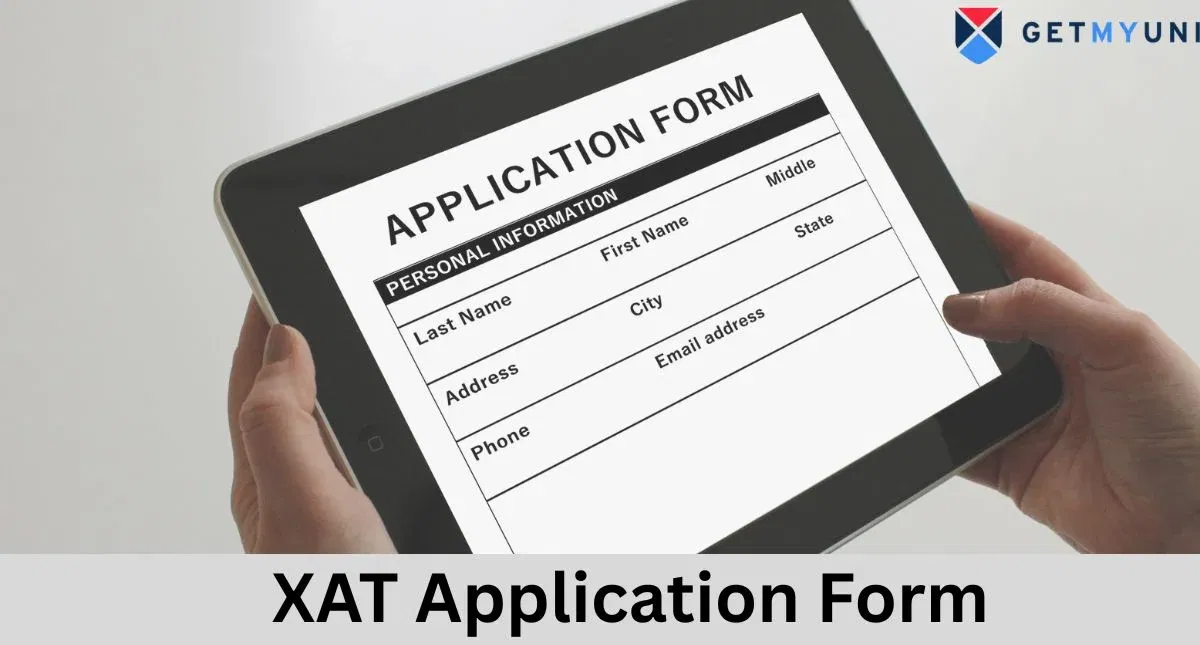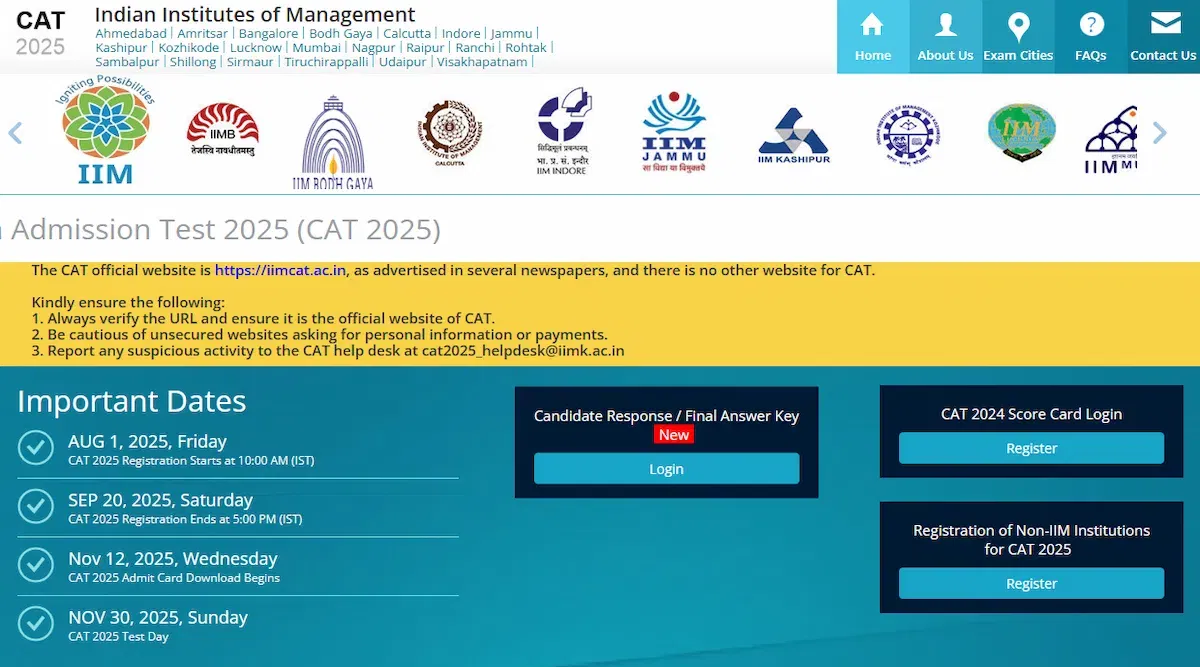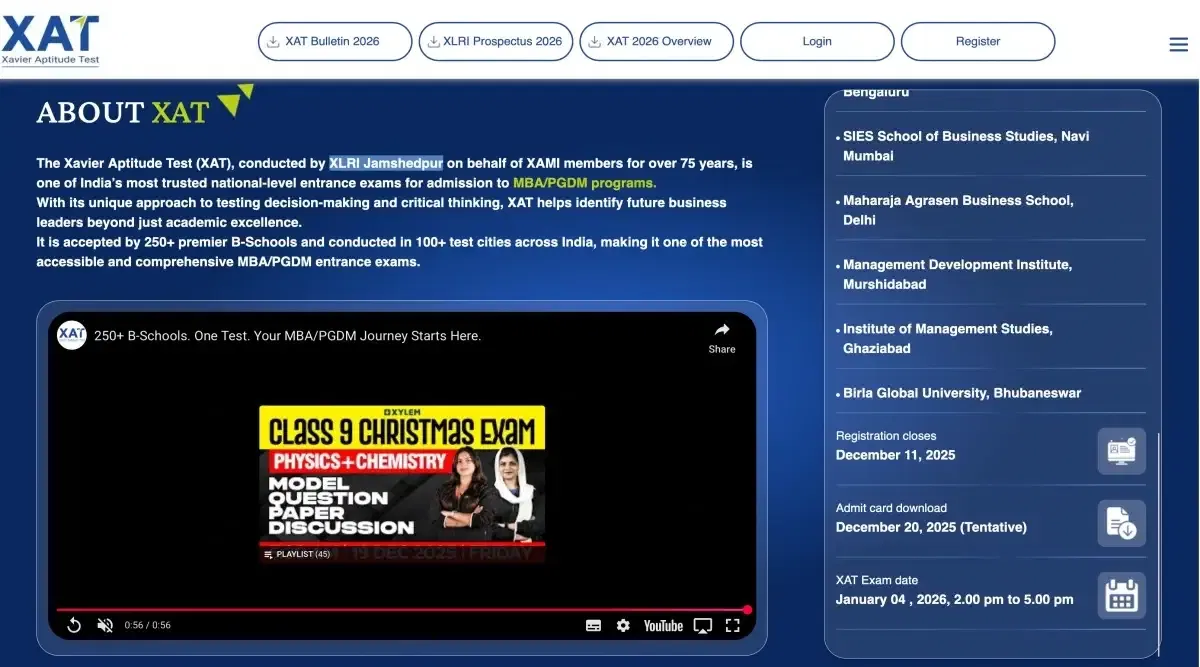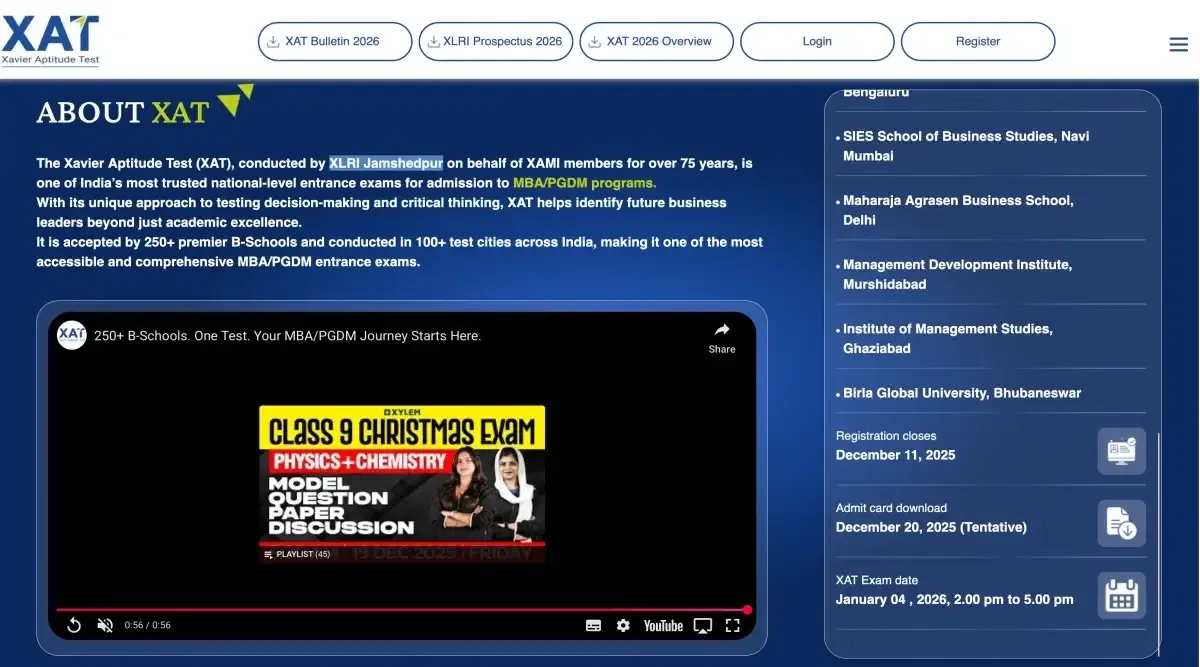Want to know about the major differences between XAT vs CAT? Both XAT and CAT exams have differences in marking schemes and exam patterns. There are five sections in the XAT exam and three sections in the CAT exam.
Table of Contents
To a certain extent, CAT and XAT show similarities, but significant differences exist in the exam pattern and marking schemes. The CAT exam comprises three sections: Data Interpretation and Logical Reasoning, Verbal Ability and Reading Comprehension, and Quantitative Aptitude.
The XAT exam has five sections: Quantitative Ability and Data Interpretation, Decision Making, Verbal and Logical Ability, General Knowledge, and Essay Writing. These two are the most common tests written by MBA aspirants among the pool of other entrance exams. The article will brief you about the major differences between XAT vs CAT.
XAT vs CAT Differences
While both these tests are the flagship management entrance exams of moderate to high difficulty levels, the common notion among students is that XAT is more difficult than CAT. Let’s look into the different factors determining major differences in XAT vs CAT:
1. XAT vs CAT - Eligibility Criteria
Attempting the XAT exam requires a candidate to hold a Bachelor’s Degree of a minimum of three years duration or equivalent in any discipline.
The CAT exam has the same eligibility criteria but with a requirement of at least 50% aggregate marks or equivalent CGPA in the Bachelor’s Degree or equivalent.
2. XAT vs CAT - Exam Pattern
While discussing the CAT vs XAT test pattern of both exams is somewhat similar; both CAT and XAT have MCQ-type questions. However, the marking scheme is different for both exams.
| Particulars in Exam Pattern | CAT | XAT |
| Total Number of Questions | 76 | 102 |
| Number of Sections | 3 | 2 |
| MCQ Type Questions | 22 | 100 |
| Non-MCQ Type Questions | 54 | - |
| Total Duration | 120 minutes | 180 minutes |
CAT’s paper is divided into three sections, whereas XAT’s format is a tad different as it has 2 parts and a total of 4 sections. The DILR section in CAT and Decision Making in XAT are unique to the respective exams. Additionally, XAT has a General Knowledge section. However, the score of Part 2 is not taken into consideration while calculating the XAT percentile.
Also Read: XAT 2026 Preparation in 1 Month
CAT Question Paper Pattern
New changes were made in the exam pattern, particularly reducing the number of questions and the time duration of the exam.
Originally there are 100 questions with a duration of 180 minutes, which has been reduced to 76 questions, and the answering time is 2 hours. The question pattern is as follows:
| Sequence | Name | Number of Questions | Time Limit |
| 1 | Verbal Ability & Reading Comprehension (VARC) | 26 | 40 minutes |
| 2 | Data Interpretation & Logical Reasoning (DILR) | 24 | 40 minutes |
| 3 | Quantitative Aptitude (QA) | 26 | 40 minutes |
The CAT syllabus topics are provided to the candidates for a better understanding of the syllabus. Furthermore, it helps in assessing the CAT exam difficulty level and candidates can start their preparation accordingly.
Also Read: How to Improve Reading Comprehension for CAT Exam?
Verbal Ability
- Reading Comprehension
- Vocabulary-Based (Synonyms/ Antonyms)
- Usage of Grammar
- Critical Reasoning (and its numerous applications)
- Idioms
- Sentence Correction
- Analogies or Reverse Analogies
- Para Completion
- Facts Interference Judgment
- Fill in the Blanks
Data Interpretation & Logical Reasoning (DILR)
- Charts/ Tables (Bar Chart, Pie Chart, Caselets, Line Charts)
- Column Graphs
- Venn Diagrams
- Pie Chart
- Direction Sense
- Puzzles
- Series
- Clocks and Calendars
- Data Structures
- Blood Relations
- Arrangements
- Coding-Decoding
Also Read: CAT Data Interpretation and Logical Reasoning Syllabus
Quantitative Aptitude
- Arithmetic: HCF, LCM, Ratio & Proportion, Simplification, Average, Age Calculation, Time & Work, Distances, Number Systems
- Algebra: Hypothesis of Equations, Quadratic Equation, Permutation, Combination, Sequence and Series
- Mensuration: Areas and Volumes – Rectangles, Squares, Triangles, Circles, Cubes, Cones, Spheres, Pipes, and Cistern.
- Percentage
- Logarithm
- Set Theory & Function
- Simple and Compound Interest
- Trigonometry
- Calculus
- Geometry
Also Read: How to Prepare for CAT Exam at Home?
XAT Question Paper Pattern
XAT is a 180-minute duration exam divided into two parts of 165 minutes and 15 minutes respectively. There are no sectional time limits in the first part of the paper. Displayed below is the question pattern:
| Sections | Number of Questions | Time Limit |
| Part-1 (75-questions) | ||
| Verbal and Logical Ability | 26 | 165 |
| Decision Making | 24 | |
| Quantitative Aptitude & Data Interpretation | 26 | |
| Part-2 (25-questions) | ||
| General Knowledge | 25 | 15 minutes |
| Total | 100 | 180 minutes |
XAT syllabus consists of verbal and logical ability, decision-making, and quantitative ability. Usually, there are limited critical reasoning and a few logical reasoning-based questions in the XAT exam.
The presence of the decision-making section in XAT certainly turns out to be one of the major contrasting factors between the two tests.
Furthermore, candidates are expected to score 70% and above in quantitative aptitude and data interpretation part to rank good.
For the general knowledge section, candidates are needed to keep themselves updated with current affairs and news topics. The elaborate syllabus mentioned below will help in recognising the XAT exam difficulty level.
Also Read: XAT Quantitative Aptitude Syllabus 2026
Verbal and Logical Ability
- English Vocabulary based questions: Antonyms and Synonyms, Usage of Grammar, Para completion, and para jumble
- Critical Reasoning
- Correction of errors in sentences, correct use of words
- Completion of sentences
- Narration of Incidents
- Literature and fiction
Decision Making
- Conditions and Grouping Test
- Data Arrangement Test
- Decision Making in a situation
- Case Lets
- Analytical Reasoning
- Situational Questions
Quantitative Ability and Data Interpretation
- Arithmetic: HCF, LCM, Ratio & Proportion, Simplification, Average, Age Calculation, Time & Work, Distances, Number Systems
- Algebra: Hypothesis of Equations, Quadratic Equation, Permutation, Combination, Sequence and Series
- Mensuration-Areas and Volumes – Rectangles, Squares, Triangles, Circles, Cubes, Cones, Spheres, Pipes, and Cistern.
- Geometry
- Probability
- Profit and Loss
- Quadratic Equations
- Logarithm
- Statistics
- Linear Equations
- Trigonometry
Also Read: XAT Essay Topics 2026
General Knowledge
- Conventional GK
- Constitution of India
- Business & Economy
- Books & Authors
- Capitals & Currencies
- International Relations
- Merger & Acquisitions
- Nation and States
- Literature
- Awards and Recognitions
- Economics
Also Read: How to Prepare for XAT Verbal Ability 2026
XAT vs CAT - Marking Scheme
Marking schemes in an MCQ-type paper typically disclose how many marks are awarded for correct answers and how many marks are penalized for incorrect answers, if there is such a penalty of negative marking.
Thus, it is of the great importance of deciding while answering a question what impact it could have in case of marking the wrong answer.
However, CAT is not fully MCQ-based, there are some TITA (type in the answer) questions that do not bear any negative marking. However, the TITA questions are a bit complex and require exact precision while answering.
In contrast, XAT is a wholly MCQ-based exam with a unique penalty for unanswered questions over a set limit. Hence, candidates need to keep an eye on the number of questions they are leaving unanswered as well.
| CAT Marking Scheme | XAT Marking Scheme |
| 4 options for MCQ-type questions | 5 options for all the questions |
| + 3 for correct option | +1 for the correct option |
| -⅓ for the wrong option | -0.25 for the wrong option |
| No negative marking for Non-MCQ type questions | -0.05 penalty for every question left unattempted after 8 questions unattempted |
Key Contrasting Factors
After going through each of the important components describing the two exams, the following are the key contrasts that can be drawn for XAT vs CAT.
These factors play an important role in understanding the inherent nature and complexity of these exams faced by the candidates.
- In part 1 of XAT, students can navigate through different sections. On the contrary, each section in CAT has a sectional time limit and candidates cannot navigate between different sections.
Thus, a time surplus in one section cannot be carried over to the next section. This is one of the downfalls of CAT’s pattern.
- MCQs in CAT have 4 options, while all the questions in XAT have 5 options and are often said to be so close to each other that it makes it difficult for students to select the correct option.
- XAT score generally depicts lesser acceptability than the CAT score as limited institutions use the XAT score as qualifying criteria for admissions.
And it is also evident from the fact that the number of people appearing for CAT is almost double the number for XAT.
- One of the most important aspects of writing these tests is question selection. Selecting the right questions while attempting the paper can be a winning strategy but it is time-consuming.
- In XAT, while question selection is crucial, one has to be cautious of even leaving questions unattempted. There is a penalty of 0.05 marks for every unattended question after 8 questions.
Also Read: What is a Good Score in XAT 2026?
XAT Difficulty Level Compared to CAT
XAT’s Decision Making and General Knowledge sections are missing from CAT. Even though the difficulty level is comparable for both XAT and CAT (moderate to difficult), the presence of these sections makes XAT complex and challenging.
On the contrary, XAT does not have sectional time limits, which helps candidates prioritize their strong areas.
This way a student can have a set strategy as to how much time they will consume on a particular section depending on the difficulty level. In CAT, one can only have a sectional strategy.
Management aspirants are curious throughout their journey in pursuit of performing well in competitive exams. They often compare exams regarding their difficulty level and complexity.
Since more students appear for CAT, they often ask whether CAT preparation is enough for XAT, leading to debates about whether CAT is tougher than XAT or vice-versa. The answer is two folds:
- First, the basic concepts are pretty much the same and students need a solid foundation to understand the concepts.
- Second, since there are noticeable differences in exam patterns and sections, XAT requires a different approach and preparation strategy.
Different exam formats ask for crafting different preparation strategies for both these tests. Here is some quick information about XAT vs CAT.
| Exam Details | XAT | CAT |
| Full Form | Xavier Aptitude Test | Common Admission Test |
| Conducting Body | Xavier School of Management (XLRI) | Indian Institutes of Management for admissions into (IIM) |
| Exam Mode | Computer-Based Test | Computer-Based Test |
| Exam Pattern | MCQ | MCQ |
| Exam Level | Comparatively Higher | Moderate to High |
Also Read: Is XAT Tougher than CAT?























POST YOUR COMMENT